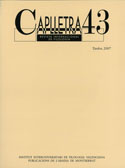Una lectura del «Llibre de Meravelles» como "ars praedicandi"
DOI:
https://doi.org/10.7203/caplletra.43.4811Keywords:
Predication, Theology, Natural philosophy, Exempla Abstract
Abstract
The «Llibre de meravelles» is one of the best known works by Ramon Llull because of its literary dimension. Both this and the structure of the text correlate with contemporary texts of encyclopaedic character. However, a contextualization of the book within Llull’s production, especially in relation to his former novel (Blanquerna), can
make important contributions to a new approach to the book, in order to interpret it as a manual of predication adapted to Llull’s particular conception. Which his conception is, which purpose Felix’s examples have in the book, and how the work integrates in Llull’s conception of relationships between faith and reason, is the subject
of the present article.
 Downloads
Downloads
Downloads
Published
How to Cite
-
Abstract366
-
PDF (Català)211
Issue
Section
License
Authors submitting work to Caplletra for publication must be the legitimate holder of the usage rights. Legitimacy for the purposes of publishing the work must also include images, tables, diagrams and any other materials that may complement the text, whether they are the author of such material or not.
Copyright: on publishing their work in the journal, the author grants Caplletra. Revista Internacional de Filologia usage rights (reproduction, distribution and public communication) for both the paper printed version and for the electronic version.
All work published in Caplletra is covered by the Creative Commons license type Attribution-NonCommercial-NoDerivatives 4.0 (CC BY-NC-ND 4.0).
RESPONSABILITY
Caplletra. Revista Internacional de Filologia does not necessarily identify with the points of view expressed in the papers it publishes.
Caplletra. Revista Internacional de Filologia accepts no responsibility whatsoever for any eventual infringement of intellectual property rights on the part of authors.






